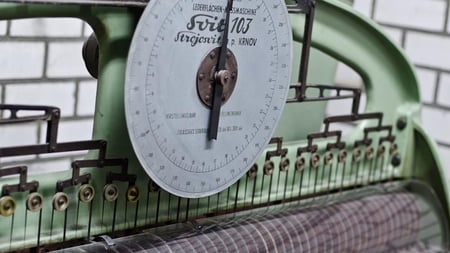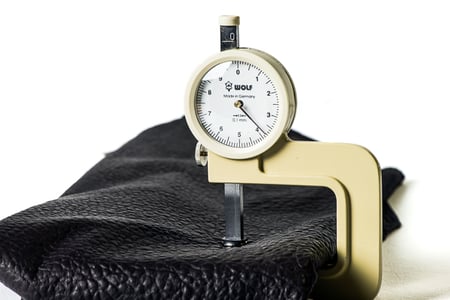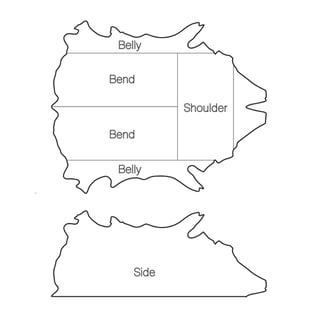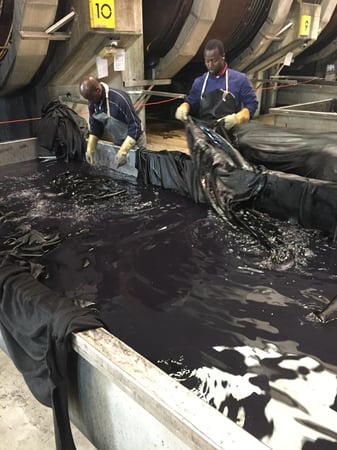How is leather actually measured?
It seems like an obvious question, but practice has taught us that it is good to dwell on the answer. You can say that today most leather is measured in "square meters = m2". As an area measure, 1 m2 is a daily and clear concept for most people. Modern measurement is done by passing the skin through a machine that reads the surface and can also write the correct size on it at the same time. The dimensions of each skin will of course differ, and at the end of the day a price will be determined per square meter. So it is important that everyone knows how big a whole skin is and that no differences of opinion can arise about it.
In the past, people in the industry worked a lot with the term "square foot". The size of a square foot is 30.48 cm x 30.48 cm. You can also convert it, we maintain that 1 m2 equals 10,764 square feet. You will hear us use both terms. To make it even more complicated, other surface sizes have been used in the past.
You will understand that every skin has a different size and therefore we can not supply standard skins with all of them exactly the same size. A skin remains a unique thing, there are no 2 the same. If we get a question about a leather hide with an intended size of 4.0 m2, there is a good chance that the actual size will eventually deviate slightly from it. (for example 3.90 m2 or 4.25 m2).


How do you measure the thickness of the leather?
In addition to the size of a skin in m2, another important measuring property is the thickness of the leather. You want to make a product out of leather and that includes a certain thickness for you. A complete bovine skin can be as much as 6 to 7 millimeters thick. But you can not really work with that. The leather is simply too thick to be handled. Thus, the skin is split and scraped to the desired thickness. Thanks to modern machines, all of this can be done very accurately. For example, we supply smooth natural shoulders that are offered in different thicknesses. From 1.0-1.25 mm., to 1.25 -1.50 mm. They are small leaps, but important for those who have to work with them.
With the thickness meter, we often check in the warehouse again to see if the correct thickness has been realized. We ourselves can then no longer correct the leather in terms of thickness. For that, we go to specialized companies, or tanneries that can carry it out on commission.
Let yourself be advised on which type of leather you can best use. We are happy to give you the right advice!
What parts does a leather skin have?
We all know what a whole skin is and what it looks like. However, for the processing of the skin, different parts are cut out depending on what one would like to use the leather for. So, for a furniture leather, you often employ whole skins. Large pieces are needed to line the parts of a sofa. But if you only want to make belts, you can also use another, smaller part of the skin. All those parts of a "cut" skin have been given names. You have probably heard them, but you may not always have been able to place them.
What exactly is a side, a butt or a double bend? What characterizes a cow's neck or shoulder? You can already see it a little better in the pictures. For us, it may be easy, yet we understand that it can be useful to label the most important parts of a hide:


How does leather get its color?
We only know purple cows from the chocolate commercials! Of course, there is purple leather, and leather in many other colors. If you can think of it, then the color likely exists. Up to bright neon colors! How do they actually dye those skins?
Leather can be dyed in any color possible. But how does that happen now? Of course, there are different ways to dye the leather. For example, we speak of dyed through or drum-dyed leather when the leather has been worked in large drums. By adding dyes and continuously rotating the drums, all skins are dyed very evenly. They all have ample opportunity to absorb the dyes.
When they come out of the drum, they have an even color. That does not mean that the dyeing is over. In a second step, a paint layer can still be applied to the top. Let's say, the "finishing" touch. Spray tunnels or cabins are used for this. Even when the leather is completely finished, an artist can still beautify the leather adding his personal touch!
